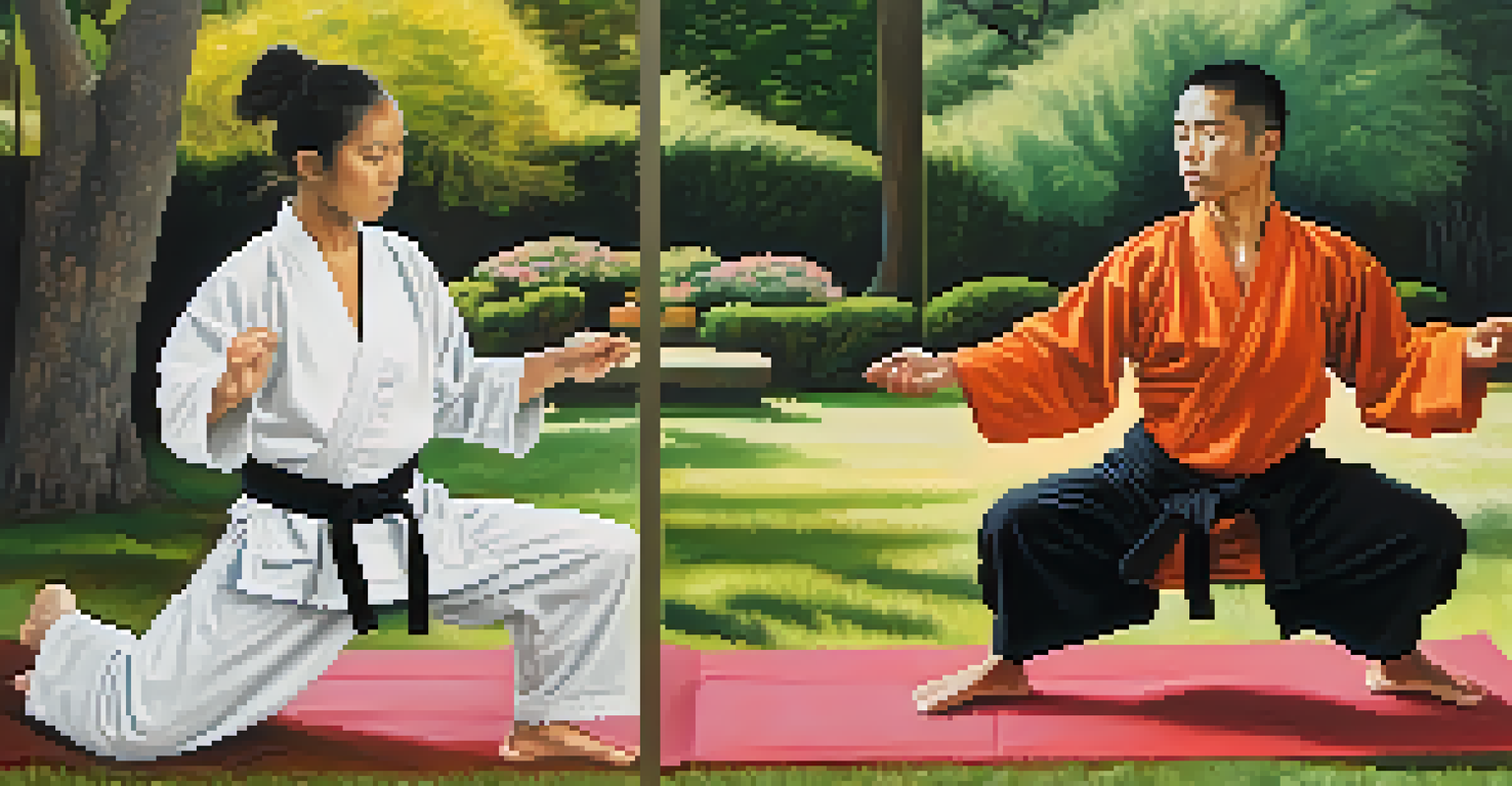Flexibility and Agility: Essentials for Effective Self Defense

Understanding Flexibility and Its Importance in Self Defense
Flexibility is the ability of your muscles and joints to move through a full range of motion. In self-defense, this means being able to dodge attacks, escape holds, or strike effectively. Imagine a rubber band; it can stretch and return to its original shape, just as your body should be able to adapt quickly in a tense situation.
The body achieves what the mind believes.
When you practice flexibility, you not only improve your physical capabilities but also boost your confidence. Knowing that your body can react swiftly gives you a psychological edge. For example, a flexible fighter can maneuver around an opponent's attacks, making it harder for them to land a hit.
Incorporating stretches and flexibility exercises into your routine is crucial. Activities like yoga or dynamic stretching can enhance your overall performance, making you more capable in a self-defense scenario.
The Role of Agility in Evading and Countering Attacks
Agility refers to the ability to move quickly and change direction with ease. In self-defense, this skill is vital for evading attacks or repositioning yourself to launch a counter. Think of a cat; its ability to dart away from danger showcases perfect agility, which can be an essential trait in self-defense.

When faced with an aggressor, being agile allows you to respond effectively rather than simply react. Quick footwork can create distance from a threat, giving you time to think and plan your next move. For instance, in a self-defense class, students often practice drills that emphasize lateral movement to evade incoming strikes.
Flexibility Enhances Self-Defense
Improving flexibility allows for better movement and adaptability in self-defense situations.
Training agility can involve drills that focus on quick changes in direction or speed. Incorporating ladder drills or cone exercises into your practice will enhance your responsiveness, making you a more formidable opponent.
How Flexibility and Agility Work Together
Flexibility and agility are like two sides of the same coin in self-defense. Good flexibility allows for a wider range of motion, while agility enables quick adaptations. Picture a dancer; their grace and fluidity come from both being flexible and agile, which is equally important in a self-defense context.
Strength does not come from physical capacity. It comes from an indomitable will.
When you combine these two attributes, you create a well-rounded defense strategy. For example, a flexible individual can avoid an attack by bending low, while an agile person can quickly pivot to counterattack. This synergy can often be the difference between escaping a situation and being caught off guard.
Training that focuses on both elements can lead to better outcomes. Activities that combine strength, speed, and flexibility, such as martial arts or functional fitness, can help you build a strong foundation for effective self-defense.
The Benefits of Improved Flexibility for Self Defense
Improving your flexibility can have various benefits beyond just self-defense. Increased flexibility can enhance your overall physical health, reduce the risk of injuries, and improve posture. This means that, in addition to being better equipped to defend yourself, you’ll feel more comfortable in your day-to-day movements.
For instance, someone who practices regular stretching or yoga may find that they can perform daily tasks, like bending down to tie their shoes, with ease. This ease in movement translates to a heightened sense of awareness in situations where self-defense might be necessary.
Agility is Key to Evading Threats
Agility helps you move quickly and change direction, which is crucial for avoiding attacks.
Additionally, a flexible body can recover from physical exertion more effectively. This resilience is crucial during a self-defense situation, as it allows you to maintain your stamina and agility when it counts.
Agility Training Techniques for Self Defense
Agility training is essential for anyone looking to enhance their self-defense skills. There are various techniques you can employ, such as agility ladder drills, cone drills, and shuttle runs. These exercises not only improve your speed but also help you develop coordination and body control, which are vital during confrontations.
For example, a simple cone drill can help you practice quick pivots and accelerations. As you navigate through the cones, your mind will also be training to assess your surroundings and react accordingly. This kind of training is akin to a video game, where quick reflexes can make all the difference between success and failure.
Integrating these drills into your routine can yield significant improvements. Over time, you’ll notice that your ability to react to unexpected situations enhances, making you more confident in your self-defense capabilities.
Mental Aspects of Flexibility and Agility in Self Defense
While physical capabilities are crucial, the mental aspect of flexibility and agility is equally important. Being mentally flexible means adapting your strategies based on the situation at hand. In self-defense, this could mean recognizing when to retreat rather than engage in a confrontation.
Agility in thought allows you to remain calm under pressure, making it easier to assess your options. For instance, if you find yourself cornered, a quick mental shift can help you identify an escape route or a way to negotiate the situation rather than react impulsively.
Combine Skills for Effective Defense
Integrating flexibility and agility creates a well-rounded self-defense strategy that boosts confidence and effectiveness.
Practicing mindfulness and visualization techniques can help sharpen your mental flexibility. Imagining various scenarios can prepare you for real-life situations, allowing you to respond with agility when it matters most.
Embracing a Well-Rounded Training Approach for Self Defense
To truly excel in self-defense, it's essential to adopt a well-rounded training approach that incorporates flexibility, agility, strength, and mental resilience. Just as a tree needs strong roots to withstand storms, your self-defense skills need a solid foundation built on diverse training methods.
By integrating various techniques from different disciplines, such as martial arts, yoga, and agility drills, you can create a holistic training regimen. This approach prepares you not only physically but also mentally for any potential threats you may face.

Ultimately, the goal of self-defense training is to empower you. By embracing a comprehensive training strategy, you're not just learning how to defend yourself; you’re cultivating confidence and readiness to navigate life's challenges, both on and off the mat.